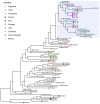Spreading of the High-Pathogenicity Avian Influenza (H5N1) Virus of Clade 2.3.4.4b into Uruguay
- PMID: 37766312
- PMCID: PMC10536905
- DOI: 10.3390/v15091906
Spreading of the High-Pathogenicity Avian Influenza (H5N1) Virus of Clade 2.3.4.4b into Uruguay
Abstract
Background: Avian influenza viruses (genus Alphainfluenzavirus, family Orthomyxoviridae) infect avian and mammal hosts. In 2022, the high pathogenicity avian influenza virus (H5N1) spread to South America, resulting in the loss of thousands of wild birds, including endangered species, and severely impacting the global poultry industry.
Objectives: We analyzed the complete genomes of influenza viruses obtained from wild birds and backyard poultry in Uruguay between February and May 2023.
Methods: Twelve complete genomes were obtained in 2023 from cloacal swabs using Illumina sequencing. Genomes were phylogenetically analyzed with regional and global strains.
Findings: The identified strains have multiple basic amino acids at the hemagglutinin cleavage sites, which is typical for highly pathogenic strains. The Uruguayan viruses belonged to hemagglutinin clade 2.3.4.4b of the H5N1 subtype. A reassortment in North America has resulted in some segments of South American strains being of Eurasian or North American origins. The Uruguayan viruses shared a common ancestor with South American strains from Argentina and Chile. The influenza viruses displayed a spatiotemporal divergence pattern rather than being host-specific.
Main conclusions: The arrival of the 2.3.4.4b clade in Uruguay may have been mediated by birds that acquired the virus from Argentine and Chilean waterfowl migrating in the Pacific Flyway.
Keywords: AIV; South America; backyard poultry; genetic lineage; wildlife.
Conflict of interest statement
The authors declare that there are no conflict of interest.
Figures



References
-
- Spackman E. Avian Influenza Virus. Humana Press; Totowa, NJ, USA: 2008. A Brief Introduction to the Avian Influenza Virus; pp. 1–6. - PubMed
Publication types
MeSH terms
Substances
LinkOut - more resources
Full Text Sources
Medical

